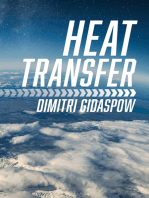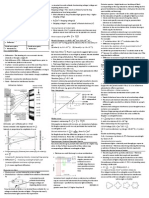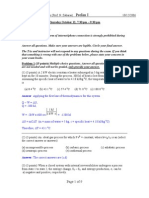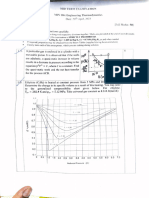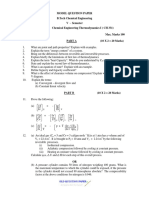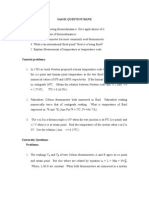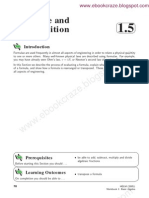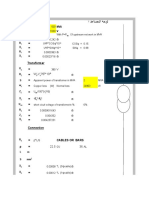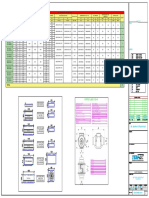Tutorial 1 (Lecture 1-3)
Tutorial 1 (Lecture 1-3)
Uploaded by
eja70Copyright:
Available Formats
Tutorial 1 (Lecture 1-3)
Tutorial 1 (Lecture 1-3)
Uploaded by
eja70Original Description:
Copyright
Available Formats
Share this document
Did you find this document useful?
Is this content inappropriate?
Copyright:
Available Formats
Tutorial 1 (Lecture 1-3)
Tutorial 1 (Lecture 1-3)
Uploaded by
eja70Copyright:
Available Formats
CCB 2024 Chemical engineering thermodynamics September 2013
1
Tutorial No. 1 (Lecture 1-3)
Questions
1. A mass of 1.2 kg of air at 150 kPa and 12
o
C is contained in a gas-tight, frictionless piston-
cylinder device. The air is now compressed to a final pressure of 600 kPa. During the
process, heat is transferred from the air such that the temperature inside the cylinder
remains constant. Calculate the work done during this process. Given, the gas constant of
air is 0.287 kJ/kg. K.
2. one mole of an ideal gas with C
p
=(7/2)R and C
v
=(5/2)R expand from P
1
=8 bar and T
1
=600K
to P
2
=1 bar by each of the flowing paths:
(a)Constant volume (b) Constant temperature (c) Adiabatically
Assuming mechanical reversibility, calculate W, Q, U, and H for each process. Sketch each
on a single PV diagram. (Problem 3-8, Smith et al. 2005)
3. An ideal gas initially at 600 K and 10 bar undergoes a four-step mechanically reversible cycle
in a closed system .in step 12, pressure decreases isothermally to 3 bar, in step 23, pressure
decreases at constant volume to 2 bar,in step 34, volume decreases at constant pressure;
and in step 41 ,the gas returns adiabatically to the initial state. Take Cp=(7/2)R and
C
v
=(5/2)R
(a) Sketch the cycle in PV diagram.
(b) Determine (where unknown) both T and P or state 1, 2, 3, and 4.
(c) Calculate W, Q, U, and H for each step of the cycle.
(Problem 3-9, Smith et al. 2005)
4. An ideal gas, C
p
=(5/2)R and C
v
=(3/2)R, is changed from P=1 bar and V
1
t
=12 m
3
to P
2
=12
and V
2
t
=1 m
3
by the following mechanically reversible process:
(a) Isothermal compression
(b) Adiabatic compression followed by cooling at constant volume.
(c) Heating at constant volume followed by cooling at constant pressure
(d) Cooling at constant pressure followed by heating at constant volume
Calculate Q, W, U
t
and H for each of these processes and sketch the paths of all
processes on a single PV diagram. (Problem 3-10, Smith et al. 2005)
5. one cubic meter of an ideal gas at 600 K and 1000 KPa expend to five times its initial
volume as follows:
(a) By a mechanically reversible, isothermal process
(b) By a mechanically reversible, adiabatic process
(c) By an adiabatic, irreversible process in which expansion is against a restraining
pressure of 100KPa
CCB 2024 Chemical engineering thermodynamics September 2013
2
For each case calculate the final temperature, pressure and the work done by the gas. C
p
=21
Jmol
-1
K
-1
. (Problem 3-19, Smith et al. 2005)
6. one mole o an ideal gas, initially at 30c temperature (303.15 K) and 1 bar, is changed to
130c(403.15 K) and 10 bar by three different mechanically reversible processes:
The gas is first heated at constant volume until its temperature is 130c; then it is
compressed isothermally until its pressure 10 bar
The gas is first heated at constant pressure until its temperature is 130c; then it is
compressed isothermally to 10 bar
The gas is first compressed isothermally to 10 bar; then it is heated at constant pressure
to 130c
Calculate W, Q, U, and H for each case, of the cycle. Take C
p
=(7/2)R and C
v
=(5/2)R.
alternatively, take C
p
=(5/2)R and C
v
=(3/2)R. ((Problem 3-22, Smith et al. 2005)
7. Nitrogen at 150 K has a specific volume of 0.041884 m
3
/kg. Determine the pressure of
nitrogen, using
(a) The ideal gas equation and
(b) The Beattie-Bridgeman equation.
Compare your results to the experimental value of 1000 kPa. (Problem 3-97, Cengel et al)
8. Determine the pressure of water vapor at 350 C and 0.035262 m3/kg, using
(a) The ideal gas equation, and
(b) The generalized compressibility chart
Which method is suitable if the experimental value of is 7.0 MPa? Justify?
9. Reported values for the virial coefficients of isopropanol vapor at 200 (473.15 K) are:
Calculate V and Z for isopropanol vapor at 200 (473.15 K) and 10 bar by
(a) The ideal-gas equation
(b) Truncated virial equation (2 terms)
(c) Truncated virial equation (3 terms)
1 +
( ters)
1 +
( ters)
Formulae:
You might also like
- Assignment 1 CpdicDocument4 pagesAssignment 1 Cpdiceja70No ratings yet
- 8185physics Unit 3 and 4 Cheat Sheet MHSDocument4 pages8185physics Unit 3 and 4 Cheat Sheet MHSSyed Mairaj Ul Haq100% (1)
- Porject Submitted By-: Project MentorDocument37 pagesPorject Submitted By-: Project MentorPritam100% (2)
- Setting Out in SurveyingDocument30 pagesSetting Out in SurveyingAkankwasa Ronald100% (2)
- Tutorial 3 - Questions Only - PVT Behavior - Ideal Gas - Virial EOSDocument5 pagesTutorial 3 - Questions Only - PVT Behavior - Ideal Gas - Virial EOSMihir Kumar Mech100% (1)
- Boardwork - Closed SystemDocument12 pagesBoardwork - Closed SystemJannineNo ratings yet
- 05-1-Collection of Problems PDFDocument15 pages05-1-Collection of Problems PDFFistia MaulinaNo ratings yet
- شيت واجبDocument3 pagesشيت واجبhussamjamal432No ratings yet
- 2007 RegDocument7 pages2007 RegrajaraghuramvarmaNo ratings yet
- 化熱chapt3Document5 pages化熱chapt3卓冠妤No ratings yet
- Thermo 1Document2 pagesThermo 1Diwas GhimireNo ratings yet
- Physical ChemDocument8 pagesPhysical ChemjahmanNo ratings yet
- Homework 8 CHE 251ADocument2 pagesHomework 8 CHE 251AAbhishek AryaNo ratings yet
- ThermoII Exercise 1Document53 pagesThermoII Exercise 1Batuhan KalyoncuNo ratings yet
- Thermodynamics Derived FormulaDocument4 pagesThermodynamics Derived FormulaAlex AndersNo ratings yet
- TD WorksheetDocument4 pagesTD WorksheetrtyiookNo ratings yet
- ENGRD 221 - Thermodynamics (Prof. N. Zabaras) Prelim IDocument9 pagesENGRD 221 - Thermodynamics (Prof. N. Zabaras) Prelim IMurat TülekNo ratings yet
- Tarea 5 TermodinamicaDocument4 pagesTarea 5 TermodinamicaMario GonzalezNo ratings yet
- CHE Assignment 2Document2 pagesCHE Assignment 2Adesite GodwinNo ratings yet
- Homework #7Document3 pagesHomework #7Sebastián SantarrosaNo ratings yet
- 2nd AssignmentDocument1 page2nd AssignmentM Helmy AdityaNo ratings yet
- Assignment 1Document2 pagesAssignment 1atif irshadNo ratings yet
- Question From MoranDocument12 pagesQuestion From MoranandrewjovellanaNo ratings yet
- 2023 MteDocument6 pages2023 MteISHAAN JAIN 22114039No ratings yet
- HW 10Document2 pagesHW 10hangman001No ratings yet
- ME 231 Montazami Whharris 10-2-18 Class Work SolutionDocument15 pagesME 231 Montazami Whharris 10-2-18 Class Work SolutionJoana ArielaNo ratings yet
- CHE 220-FALL23-Homework VDocument2 pagesCHE 220-FALL23-Homework Vsemikonino35No ratings yet
- Thermodynamics Assignment 2 2014Document5 pagesThermodynamics Assignment 2 2014ravikr950% (1)
- MEG 212 Practise QuestionsdocxDocument11 pagesMEG 212 Practise Questionsdocxoyetunde ridwanNo ratings yet
- Adamson UniversityDocument3 pagesAdamson UniversityVanessa Elaine CaoNo ratings yet
- Test 1 With AnsDocument4 pagesTest 1 With AnsKavinesh GanesanNo ratings yet
- Tutorial 1 v1Document1 pageTutorial 1 v1Ravi Mohan PrasadNo ratings yet
- 8231 - 23984 - TD Q.Bank 14-15Document20 pages8231 - 23984 - TD Q.Bank 14-15విష్ణువర్ధన్రెడ్డిNo ratings yet
- MTDKDocument9 pagesMTDKraviteja1840No ratings yet
- Arjuna Series - ThermodynamicsDocument9 pagesArjuna Series - Thermodynamicsajgangster3No ratings yet
- Assignment 1, Autumn 2023Document2 pagesAssignment 1, Autumn 2023cocodarshi2022No ratings yet
- Basic ThermodynamicsDocument8 pagesBasic ThermodynamicsVivek VermaNo ratings yet
- Tutorial MED205Document4 pagesTutorial MED205Anonymous V4jDKjUR6No ratings yet
- THERMODYNAMICS RevisionDocument2 pagesTHERMODYNAMICS Revisionsuri rayNo ratings yet
- Homework 4. Evaluating Properties.: Constant. TheDocument2 pagesHomework 4. Evaluating Properties.: Constant. TheLUISRONo ratings yet
- ITK-233-2 - PVT Behavior of FluidDocument57 pagesITK-233-2 - PVT Behavior of FluidVinay GuptaNo ratings yet
- Serie N 6 SECOND LAWDocument2 pagesSerie N 6 SECOND LAWkhouloud.chihabNo ratings yet
- rr222102 Engineering ThermodynamicsDocument8 pagesrr222102 Engineering ThermodynamicsSRINIVASA RAO GANTANo ratings yet
- T1 Ug 90Document6 pagesT1 Ug 90germangsilvaNo ratings yet
- Example CH 4Document4 pagesExample CH 4Uday Prakash SahuNo ratings yet
- ThermodynamicsDocument2 pagesThermodynamicsVijetha SvNo ratings yet
- PHYSCHEM4Document2 pagesPHYSCHEM4Nikki ByrneNo ratings yet
- Qbank 18me32 BTDDocument6 pagesQbank 18me32 BTDAmaresh Movies ASNo ratings yet
- Section-1: Material-Independent Property Relations: AnswersDocument20 pagesSection-1: Material-Independent Property Relations: Answersnkosana2No ratings yet
- ET Mid Exam QP SS2020Document3 pagesET Mid Exam QP SS2020Shatakshi DwivediNo ratings yet
- KTG Thermodynamics STUDENT COPY With Ans 1692339767740Document54 pagesKTG Thermodynamics STUDENT COPY With Ans 1692339767740sukanyab345No ratings yet
- BTD Question Bank1Document16 pagesBTD Question Bank1Mahantesh ChulakiNo ratings yet
- Thermodynamics 19092013Document5 pagesThermodynamics 19092013hellow3533No ratings yet
- Thermo QualsDocument26 pagesThermo QualsLuc LeNo ratings yet
- AE May 2013 04 BS 10Document4 pagesAE May 2013 04 BS 10Amber HarrisNo ratings yet
- Ejercicios TermodinamicaDocument13 pagesEjercicios Termodinamica601195No ratings yet
- CHEG 211 Chemical Process Calculation Homework #1Document2 pagesCHEG 211 Chemical Process Calculation Homework #1ramesh pokhrelNo ratings yet
- Chapter 2 ExerciseDocument4 pagesChapter 2 ExerciseMousa Floobert موسىNo ratings yet
- A Modern Course in Statistical PhysicsFrom EverandA Modern Course in Statistical PhysicsRating: 3.5 out of 5 stars3.5/5 (2)
- Assignment 2Document4 pagesAssignment 2eja70100% (1)
- The 12 Principles of Green Analytical Chemistry and The Significance Mnemonic of Green Analytical PracticesDocument2 pagesThe 12 Principles of Green Analytical Chemistry and The Significance Mnemonic of Green Analytical Practiceseja70No ratings yet
- CCB 2063 Separation Processes: CrystallisationDocument35 pagesCCB 2063 Separation Processes: Crystallisationeja70No ratings yet
- Ed - Lec09 Chapter 9 - PFD PidDocument36 pagesEd - Lec09 Chapter 9 - PFD Pideja70No ratings yet
- Tutorial CondensationDocument1 pageTutorial Condensationeja70No ratings yet
- Chapter 4 - StudentDocument69 pagesChapter 4 - Studenteja70No ratings yet
- The Memory SystemDocument3 pagesThe Memory Systemeja70No ratings yet
- Ccb2053 Tutorial 1Document1 pageCcb2053 Tutorial 1eja70No ratings yet
- CCB2053 TuTorial 2Document1 pageCCB2053 TuTorial 2Yassin RoslanNo ratings yet
- Formulae and TranspositionDocument12 pagesFormulae and TranspositionEbookcrazeNo ratings yet
- VRV X Catalogue - 2023Document58 pagesVRV X Catalogue - 2023nandu jpNo ratings yet
- Analysis and Solutions To Unusual Differential Relay MisoperationDocument9 pagesAnalysis and Solutions To Unusual Differential Relay MisoperationhansamvNo ratings yet
- A1 - Baw56Document3 pagesA1 - Baw56Iván Alexander Chero CabreraNo ratings yet
- Thermodynamics ProblemsDocument13 pagesThermodynamics ProblemsKo Qurban Ahmedli :/No ratings yet
- Hysteresis Motors 1Document10 pagesHysteresis Motors 1Nelis OosthuizenNo ratings yet
- BSC Physics 18 19Document50 pagesBSC Physics 18 19Abinav A DNo ratings yet
- Caclation of Short CircuitDocument3 pagesCaclation of Short CircuitMohamed Mostafa100% (1)
- 621 Generator On-Line Over and Under Excitation IssuesDocument26 pages621 Generator On-Line Over and Under Excitation Issueswoop100% (1)
- Research Online Research OnlineDocument9 pagesResearch Online Research OnlineabdullaalakourNo ratings yet
- A.C. Static Watthour Meters, Class 1 and 2 - Specification: Indian StandardDocument38 pagesA.C. Static Watthour Meters, Class 1 and 2 - Specification: Indian StandardBikash MohapatraNo ratings yet
- Acmv Rev 04-Tem-Ac-06Document1 pageAcmv Rev 04-Tem-Ac-06NAHEEMA KPNo ratings yet
- Chapter 3 2. Polytropic or Small Stage Efficiency: PurposeDocument3 pagesChapter 3 2. Polytropic or Small Stage Efficiency: PurposeJoanna LockNo ratings yet
- Summary Group 2 Laws of ThermodynamicsDocument4 pagesSummary Group 2 Laws of ThermodynamicsNorhida PantaranNo ratings yet
- Matrix Converter ThesisDocument148 pagesMatrix Converter ThesisHollie Rosa100% (1)
- Yoke Calibration Test Bar Parker Research Corporation Mpi Magnetic Particle Inspection Probe ElectromagnetDocument2 pagesYoke Calibration Test Bar Parker Research Corporation Mpi Magnetic Particle Inspection Probe Electromagnetnewton5805No ratings yet
- Viscosity For Non-Newtonian FluidsDocument7 pagesViscosity For Non-Newtonian FluidsBao KimNo ratings yet
- PH 110 Course OutlineDocument4 pagesPH 110 Course OutlineeugeneNo ratings yet
- Hydraulic and Hydraulic MachinesDocument7 pagesHydraulic and Hydraulic MachinesAwanish PrajapatiNo ratings yet
- Cooling: Industrial ApplicationsDocument3 pagesCooling: Industrial Applicationsindra putraNo ratings yet
- June 2021 (Ial) MsDocument20 pagesJune 2021 (Ial) MsSavva LazarevNo ratings yet
- SCE Research Paper PDFDocument12 pagesSCE Research Paper PDFmuoi2002No ratings yet
- LUMISOLAR Ficha Técnica Batería AGM Sellada 100ah 12V (Mod. KBL121000)Document2 pagesLUMISOLAR Ficha Técnica Batería AGM Sellada 100ah 12V (Mod. KBL121000)sedapargoNo ratings yet
- The Application of Sweep Frequency RespoDocument6 pagesThe Application of Sweep Frequency Responamsaigon316No ratings yet
- Calculating TEG RateDocument1 pageCalculating TEG RatekarthickNo ratings yet
- PowerLine 5 2303Document2 pagesPowerLine 5 2303Cristian CombesNo ratings yet
- Laboratory Consolidation Test: Specimen Data: at Beginning of TestDocument6 pagesLaboratory Consolidation Test: Specimen Data: at Beginning of TestmdalgamouniNo ratings yet
